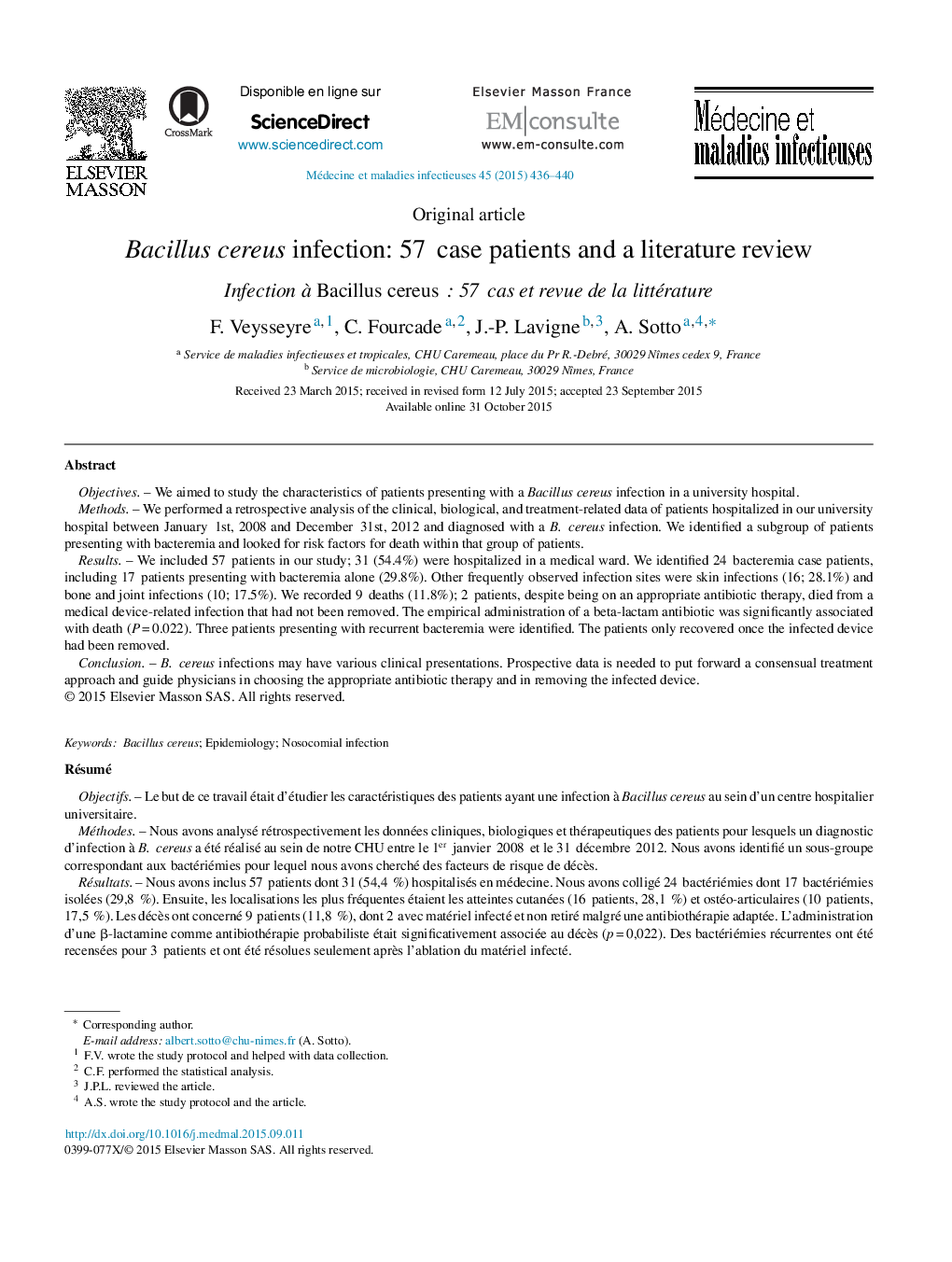| Article ID | Journal | Published Year | Pages | File Type |
|---|---|---|---|---|
| 3412433 | Médecine et Maladies Infectieuses | 2015 | 5 Pages |
ObjectivesWe aimed to study the characteristics of patients presenting with a Bacillus cereus infection in a university hospital.MethodsWe performed a retrospective analysis of the clinical, biological, and treatment-related data of patients hospitalized in our university hospital between January 1st, 2008 and December 31st, 2012 and diagnosed with a B. cereus infection. We identified a subgroup of patients presenting with bacteremia and looked for risk factors for death within that group of patients.ResultsWe included 57 patients in our study; 31 (54.4%) were hospitalized in a medical ward. We identified 24 bacteremia case patients, including 17 patients presenting with bacteremia alone (29.8%). Other frequently observed infection sites were skin infections (16; 28.1%) and bone and joint infections (10; 17.5%). We recorded 9 deaths (11.8%); 2 patients, despite being on an appropriate antibiotic therapy, died from a medical device-related infection that had not been removed. The empirical administration of a beta-lactam antibiotic was significantly associated with death (P = 0.022). Three patients presenting with recurrent bacteremia were identified. The patients only recovered once the infected device had been removed.ConclusionB. cereus infections may have various clinical presentations. Prospective data is needed to put forward a consensual treatment approach and guide physicians in choosing the appropriate antibiotic therapy and in removing the infected device.
RésuméObjectifsLe but de ce travail était d’étudier les caractéristiques des patients ayant une infection à Bacillus cereus au sein d’un centre hospitalier universitaire.MéthodesNous avons analysé rétrospectivement les données cliniques, biologiques et thérapeutiques des patients pour lesquels un diagnostic d’infection à B. cereus a été réalisé au sein de notre CHU entre le 1er janvier 2008 et le 31 décembre 2012. Nous avons identifié un sous-groupe correspondant aux bactériémies pour lequel nous avons cherché des facteurs de risque de décès.RésultatsNous avons inclus 57 patients dont 31 (54,4 %) hospitalisés en médecine. Nous avons colligé 24 bactériémies dont 17 bactériémies isolées (29,8 %). Ensuite, les localisations les plus fréquentes étaient les atteintes cutanées (16 patients, 28,1 %) et ostéo-articulaires (10 patients, 17,5 %). Les décès ont concerné 9 patients (11,8 %), dont 2 avec matériel infecté et non retiré malgré une antibiothérapie adaptée. L’administration d’une β-lactamine comme antibiothérapie probabiliste était significativement associée au décès (p = 0,022). Des bactériémies récurrentes ont été recensées pour 3 patients et ont été résolues seulement après l’ablation du matériel infecté.ConclusionLes infections à B. cereus peuvent avoir plusieurs présentations cliniques. Des données prospectives semblent nécessaires afin de pouvoir proposer une attitude thérapeutique consensuelle, notamment pour guider le clinicien vis-à-vis de l’antibiothérapie et de l’ablation de matériel.
